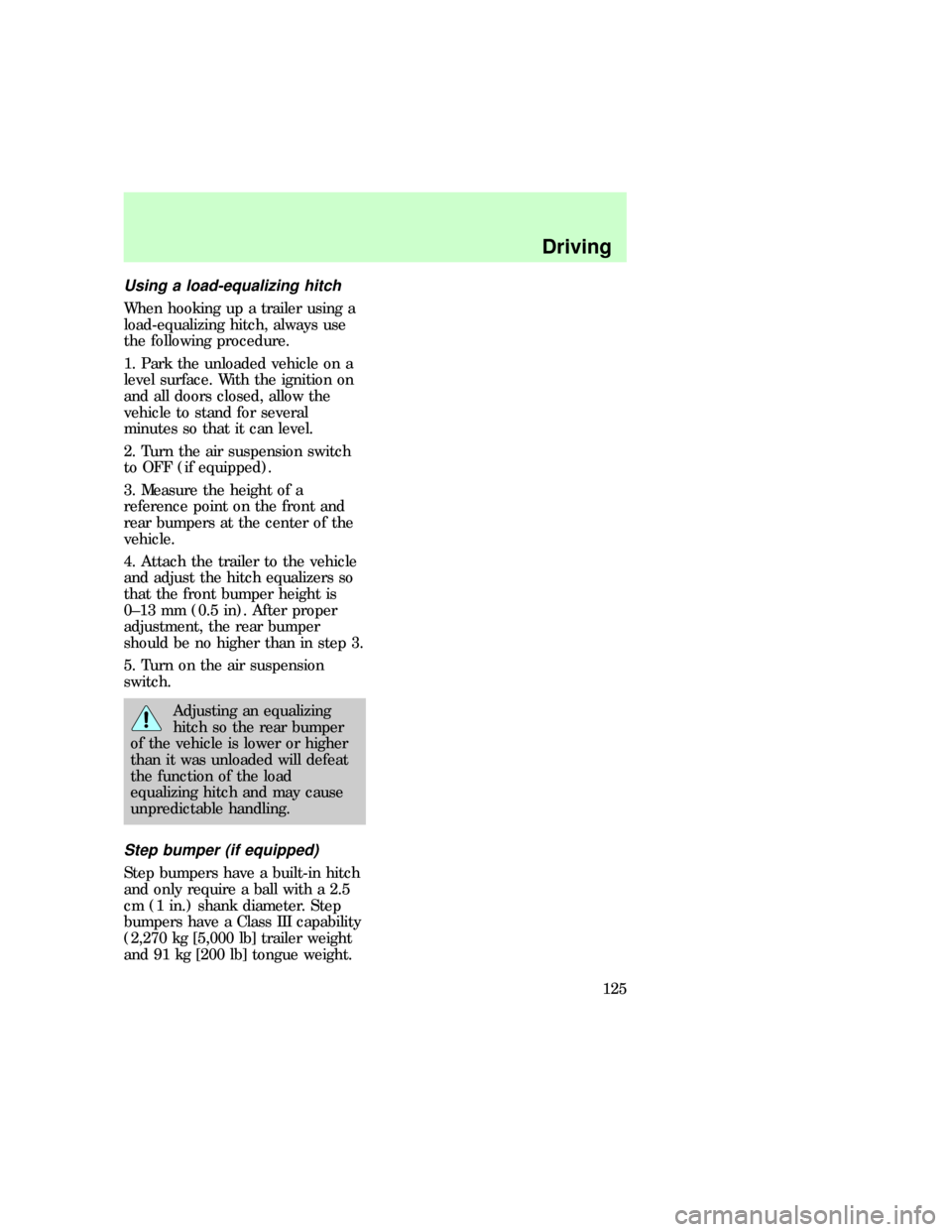Page 22 of 219
Fuel pump shut-off switch
Refer to theRoadside
emergencieschapter for
information on operating the fuel
pump shut-off switch.
f12_air_suspension
Controls and features
23
Page 23 of 219
Air suspension load leveling (if
equipped)
Your vehicle is equipped with an
air suspension system for the rear
suspension that levels your vehicle
when carrying heavy loads. Refer
toAir suspension load leveling
in theDrivingchapter for more
information.
OFF
f12_climate_controls
Controls and features
24
Page 94 of 219
particularly when one or more
wheels are on a surface with poor
traction.
AIR SUSPENSION (IF
EQUIPPED)
The air suspension system for the
rear wheels is designed to keep
your vehicle at a constant level by
adding or releasing air from the
rear springs to compensate for
increases or decreases in vehicle
load.
Normal vehicle operation does not
require any action by the driver.
The air suspension switch is
located behind an access panel
underneath the passenger side
instrument panel.
Press the air suspension switch to
OFF when jacking or hoisting your
vehicle.
On vehicles equipped with
Air Suspension, turn OFF
the Air Suspension switch prior
to jacking, hoisting or towing
your vehicle.
OFF
f12_air_suspension
f12_transmission
Driving
95
Page 124 of 219

Using a load-equalizing hitch
When hooking up a trailer using a
load-equalizing hitch, always use
the following procedure.
1. Park the unloaded vehicle on a
level surface. With the ignition on
and all doors closed, allow the
vehicle to stand for several
minutes so that it can level.
2. Turn the air suspension switch
to OFF (if equipped).
3. Measure the height of a
reference point on the front and
rear bumpers at the center of the
vehicle.
4. Attach the trailer to the vehicle
and adjust the hitch equalizers so
that the front bumper height is
0±13 mm (0.5 in). After proper
adjustment, the rear bumper
should be no higher than in step 3.
5. Turn on the air suspension
switch.
Adjusting an equalizing
hitch so the rear bumper
of the vehicle is lower or higher
than it was unloaded will defeat
the function of the load
equalizing hitch and may cause
unpredictable handling.
Step bumper (if equipped)
Step bumpers have a built-in hitch
and only require a ball with a 2.5
cm (1 in.) shank diameter. Step
bumpers have a Class III capability
(2,270 kg [5,000 lb] trailer weight
and 91 kg [200 lb] tongue weight.
f12_step_bumper
Driving
125
Page 136 of 219
Instrument panel fuses
Always replace a fuse with
one that has the specified
amperage rating. Using a fuse
with a higher amperage rating
can cause severe wire damage
and could start a fire.
Position Amps Description
1 15 Stop/turn lamps and turn indicators
2 5 Instrument cluster
3 25 Cigarette lighter
4 5 Power mirrors, autolamp, remote
anti-theft/keyless entry, headlamp relay and
parking lamp relay
5 15 Speed control, daytime running lamps, climate
control blend door, backup lamps, A/C clutch
coil
6 5 Brake-shift interlock, generic electronic module
(GEM)/central timer module (CTM) and air
suspension module
7 - Not used
8 5 Radio, remote anti-theft/keyless entry, GEM
module/CTM module
1
1
2
3
4
512 22
21323
31424
4
16 15
25
526
61727
71828
81929
11 21 31930
10 20
f12_pass_comp_fuses
Roadside emergencies
137
Page 138 of 219
Relays
Position Description
1 Interior lamps relay
2 Battery saver relay
3 Not used
4 One touch down relay
5 Accessory delay relay
Power distribution box
Lift cover towards left of vehicle to
access the power distribution box.
Always disconnect the
battery before servicing
high current fuses.
Always replace the cover
to the Power Distribution
Box before reconnecting the
battery or refilling fluid
reservoirs.
Fuses
Position Amps Description
1 20 Trailer tow back-up and tail lamps
2 10 Air bag diagnostic monitor
3 15 Power locks
4 15 Air suspension
5 20 Horn
6 15 Audio system
29
6
5
4
3
2
1 28
27
26
25
24
2319
18
17
16
15
14
13
22
21
20
12
1197531
12108642
f12_eng_comp_fuses
Roadside emergencies
139
Page 139 of 219
Fuses
Position Amps Description
7 15 Parking and tail lamps
8 30 Headlamps
9 15 Daytime running lamps and fog lamps
10 25 Auxiliary power point
11 - Not used
12 - Not used
13 - Not used
14 60/20 4WABS/rear anti-lock brake
15 50 Air suspension compressor
16 40 Trailer tow battery charge and stop/turn lamps
17 30 4WD transfer case shift motor and clutch
18 30 Driver power seat
19 20 Fuel pump
20 50 Instrument panel fuse panel ignition switch feed
21 50 Instrument panel fuse panel ignition switch feed
22 50 I/P fuse panel battery feed
23 40 I/P blower
24 30 PCM power
25 30 Power windows
26 - Not used
27 - Not used
28 30 Trailer tow electronic brake
29 - Not used
Diodes
Position Description
1 Rear ABS diode
2 PCM diode
Roadside emergencies
140
Page 142 of 219
Tire change procedure
1. Park on a level surface.
2. Activate the hazard flashers.
3. Set the parking brake.
4. Place the gearshift in P (Park)
(automatic transmission) or R
(Reverse) (manual transmission).
For 4WD vehicles equipped with
Lever-operated transfer case, make
sure that the lever is not in the N
(Neutral) position.
5. Block the diagonally opposite
wheel.
6. Remove the jack and lug wrench
from under the passenger seat.
On vehicles equipped with
Air Suspension, turn OFF
the Air Suspension switch prior
to jacking, hoisting or towing
your vehicle.
To avoid injury, never run
the engine with one wheel
off the ground, such as when
changing a tire.
f12_removing_spare
Roadside emergencies
143